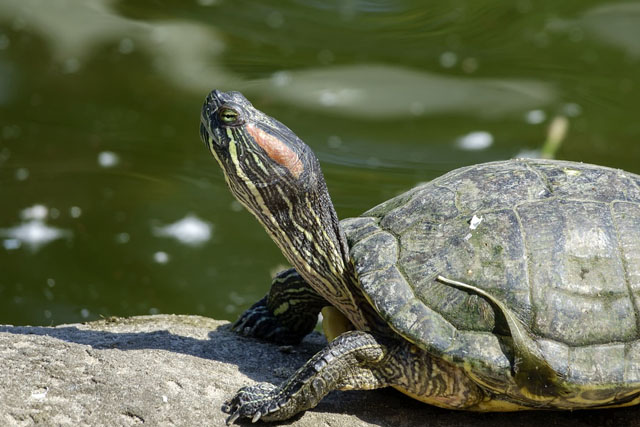



The first step in creating an aquaterrarium for turtles is to choose the right tank or enclosure. The size of the tank will depend on the size and number of turtles you have. It is recommended to have at least 10 gallons of water per inch of turtle shell length. For example, if you have a turtle with a 4-inch shell, you will need a tank that can hold at least 40 gallons of water.
Make sure the tank has a secure lid to prevent the turtles from escaping. It should also have a sturdy base to support the weight of the water and decorations.
The substrate is the material that lines the bottom of the tank. It serves as a natural habitat for the turtles and helps maintain water quality. There are several options for substrate, including gravel, sand, and aquatic plants.
Gravel is a popular choice as it is easy to clean and provides a natural look. Make sure to choose gravel that is large enough to prevent the turtles from swallowing it. Sand is another option, but it can be more difficult to clean and may require more frequent water changes. Aquatic plants can also be used as substrate, providing both a natural look and additional filtration.
A water filter is essential for maintaining clean and healthy water for your turtles. It helps remove debris, waste, and harmful chemicals from the water. There are several types of filters available, including canister filters, hang-on-back filters, and sponge filters.
When choosing a filter, consider the size of your tank and the number of turtles you have. It is recommended to choose a filter that can handle at least three times the volume of your tank. For example, if you have a 40-gallon tank, choose a filter that can handle at least 120 gallons per hour.
Turtles are ectothermic animals, which means they rely on external sources of heat to regulate their body temperature. A heater is necessary to maintain the water temperature within the appropriate range for your turtles.
The ideal water temperature for most turtle species is between 75 and 85 degrees Fahrenheit. Choose a heater that is suitable for the size of your tank and has an adjustable thermostat to maintain the desired temperature.
Turtles require UVB light to synthesize vitamin D3, which is essential for calcium metabolism and overall health. A UVB light should be provided in the tank to ensure your turtles receive adequate UVB radiation.
There are different types of UVB lights available, including fluorescent tubes and compact bulbs. Make sure to choose a UVB light that is specifically designed for reptiles and provides the appropriate UVB output for your turtle species.
Turtles need a basking area where they can climb out of the water and dry off. This area should be large enough for your turtles to comfortably rest and bask under the heat lamp.
You can create a basking area using rocks, driftwood, or a commercial turtle dock. Make sure the basking area is sturdy and secure to prevent any accidents or injuries.
Adding decorations to the aquaterrarium not only enhances the aesthetic appeal but also provides enrichment for your turtles. You can include items such as rocks, caves, plants, and floating logs.
Make sure to choose decorations that are safe for turtles and do not have any sharp edges or small parts that can be swallowed. Rinse all decorations thoroughly before adding them to the tank to remove any dirt or chemicals.
A thermometer is essential for monitoring the water temperature in the tank. It allows you to ensure that the water temperature remains within the appropriate range for your turtles.
There are different types of thermometers available, including stick-on thermometers, digital thermometers, and floating thermometers. Choose a thermometer that is accurate and easy to read.
Before adding water to the tank, it is important to treat it with a water conditioner. Tap water often contains chlorine, chloramines, and heavy metals that can be harmful to turtles.
Choose a water conditioner that is specifically designed for reptiles and follow the instructions on the label for proper dosage. Allow the water to sit for at least 24 hours after adding the conditioner to allow any residual chemicals to dissipate.
Finally, you will need to provide your turtles with a balanced diet. Turtles are omnivores and require a combination of animal protein, such as insects and fish, and plant matter, such as leafy greens and vegetables.
Choose a high-quality commercial turtle food that is specifically formulated for your turtle species. Supplement their diet with fresh fruits, vegetables, and live or frozen prey to ensure they receive all the necessary nutrients.
By following these steps and using the right materials, you can create a suitable and comfortable aquaterrarium for your turtles. Remember to regularly clean and maintain the tank to ensure the health and well-being of your turtles.
Leave a Reply
Related posts